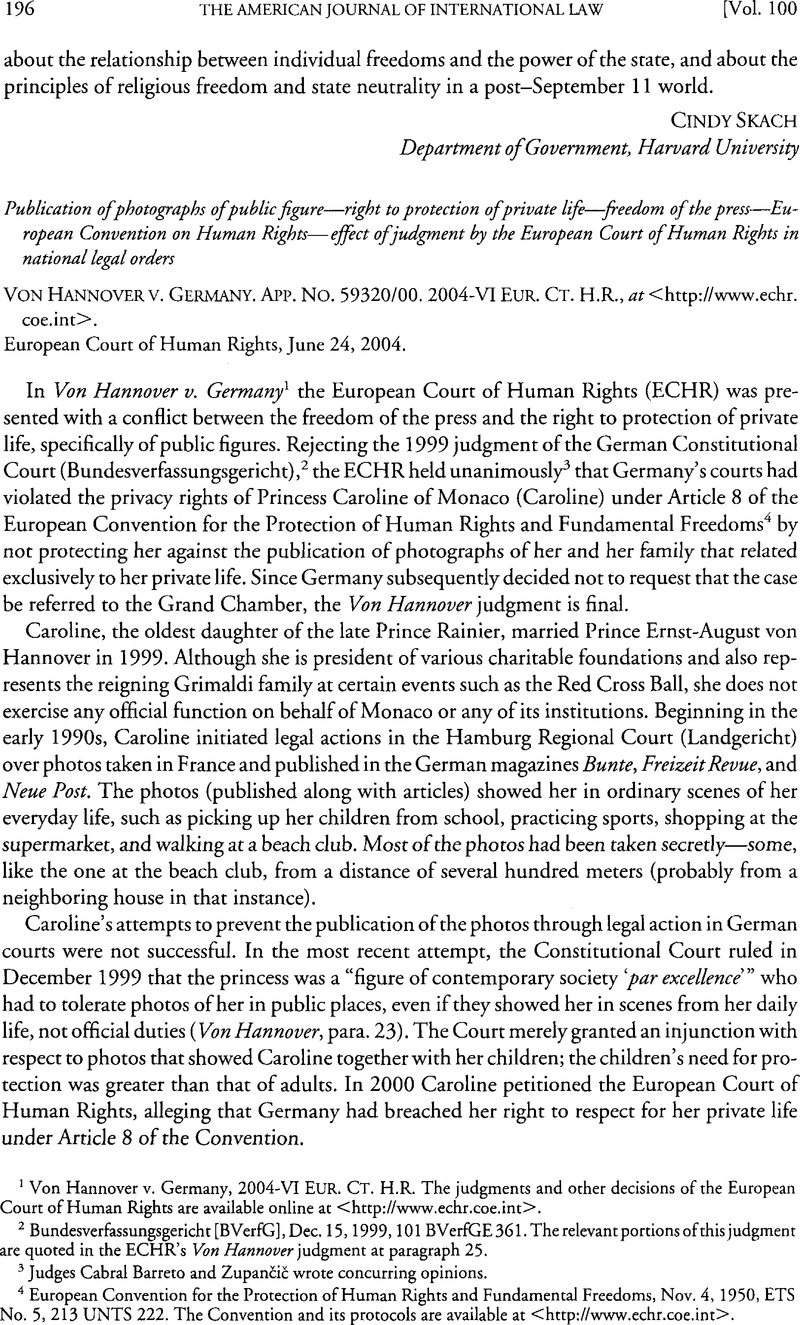Article contents
Von Hannover v. Germany. App. No. 59320/00.2004-VI Eur. Ct. H.R.
Published online by Cambridge University Press: 27 February 2017
Abstract

- Type
- International Decisions
- Information
- Copyright
- Copyright © American Society of International Law 2006
References
1 Von Hannover v. Germany, 2004-VI Eur. CT. H.R. The judgments and other decisions of the European Court of Human Rights are available online at <http://www.echr.coe.int>.
2 Bundesverfassungsgericht [BVerfG], Dec. 15,1999,101 BVerfGE 361. The relevant portions of this judgment are quoted in the ECHR’s Von Hannover judgment at paragraph 25.
3 Judges Cabral Barreto and Zupančič wrote concurring opinions.
4 European Convention for the Protection of Human Rights and Fundamental Freedoms, Nov. 4, 1950, ETS No. 5, 213 UNTS 222. The Convention and its protocols are available at <http://www.echr.coe.int>.
5 See Schüssel v. Austria, App. No. 42409/98 (Eur. Ct. H.R. Feb. 21,2002) (unpublished admissibility decision).
6 SeeP.G. v. United Kingdom, App. No. 44787/98, para. 56 (Eur. Ct. H.R. Sept. 25,2001) (unpublished admissibility decision).
7 Cf.X v. Netherlands, 91 Eur. Ct. H.R. (Ser. A) at para. 23 (1985); Airey v. Ireland, 32 Eur. Ct. H.R. (Ser. A) at para. 32 (1985). See generally Alastair, R. Mowbray The Development of Positive Obligations Under The European Convention on Human Rights by The European Court of Human Rights (2004).Google Scholar
8 In this context, the Court took one additional factor into account. By emphasizing the context in which the photos of Caroline had been taken—without her knowledge or consent, and from large distances even in protected areas such as a beach club, where journalists and photographers are generally debarred—the Court acknowledged the harassment that many public figures have to endure in their daily lives (para. 68). It is this harassment that, according to the Court, induces in public figures a very strong sense of intrusion into their private lives (para. 59).
9 Reinhard, Müller Wachhund [Watchdog], Frankfurter Allgemeine Zeitung, Sept. 10, 2004, at 1.Google Scholar Karlsruhe, a city in the south of Germany, has been the seat of Germany’s Constitutional Court since its establishment in 1951.
10 For the opinion of Hans-Jürgen Papier, president of the German Constitutional Court, see Frankfurter Allgemeine Zeitung, Dec. 9, 2004, at 5.
11 See Beuthien, Volker Das Recht auf nichtmediale Alltäglichkeit [The Right to Nonmedial Everyday Life], 7 Kommunikation & Recht 457, 459–60 (2004)Google Scholar; Jan von, Hein Die Europäisierung des Persönlichkeitsschutzes [The Europeanization of the Protection of Privacy], 2 Zeitschrift Für Gemeinschaftsprivatrecht 252 (2004)Google Scholar; Günter, Herrmann Anmerkung zum Urteil des EGMR vom 24.6.2004 [Note on the Judgment of the ECHR of June’ 24, 2004], 48 Zeitschrift Für Urheber und Medienrecht 665 (2004).Google Scholar
12 See Catherine, Dupré The Protection of Private Life Against Freedom of Expression in French Law, 5 Eur. Hum. Rts. L. Rev. 627, 635–39 (2000)Google Scholar (with reference to French case law); see also Bartnik, Marcel Der Blldnisschutz im Deutschen und Französischen Recht [Protection of Images in German and French Law] (2004).Google Scholar For a comparison of the judgment in Von Hannover with the jurisprudence in the United Kingdom, see Case Comment [on Von Hannover v. Germany], 9 Eur. Hum. Rts. L. Rev. 593 (2004).Google Scholar
13 Judge Zupančič stated in his concurring opinion that the courts—meaning the German courts—had, in the past under American influence, “made a fetish of the freedom of the press.”
14 For example, Dieter Grimm, former president of the German Constitutional Court, stated that the Von Hannover judgment was hitting the press at its core. Frankfurter Allgemeine Zeitung, July 14, 2004, at 34.
15 There is no scarcity of examples that could be so construed, such as published articles with photos showing a well-known musician, who was said to be a family man, secretly cheating on his wife, or of a young soccer star, who always appeared to be shy and reserved, involved in a street fight. In any event, there is nothing in Von Hannover that suggests that a “debate of general interest” would be limited to political topics.
16 For a persuasive analysis of this paradox, see Sanderson, M. A. Is Von Hannover v Germany a Step Backward for the Substantive Analysis of Speech and Privacy Interests? 9 Eur. Hum. Rts. L. Rev. 631, 643–44 (2004).Google Scholar
17 What makes it especially difficult is that the burden is on the celebrity to establish that he or she had been in a secluded place.
18 See, e.g., Orhan v. Turkey, App. No. 25656/94 (Eur. Ct. H.R. June 18, 2002).
19 On June 7, 2005, Germany and Caroline reached a friendly settlement according to which Germany pays Caroline a total of €115,000 in just satisfaction. This sum comprises €10,000 in compensation for nonpecuniary damage and € 105,000 for costs and expenses, including taxes. See Von Hannover v. Germany, App. No. 59320/00, Just Satisfaction—Friendly Settlement (Eur. Ct. H.R. July 28, 2005).
20 2004-11 Eur. Ct. H.R, discussed in Orakhelashvili, Alexander Case Report: Assanidze v. Georgia, 99 AJIL 222 (2005).CrossRefGoogle Scholar
21 Broniowski v. Poland, 2004-VEur. Ct. H.R. at 73.
22 See, e.g., Klein, Eckart Binding Effect of ECHR judgments, in Protection Des Droits De L’Homme: LA Perspective Européenne 705 (Mahoney, Paul ed., 2000)Google Scholar; Jochen, A. Frowein The Incorporation of the European Convention on Human Rights into the Legal Order of Germany, in O Medunarodnom I Narodnom— Festschrift Vojin Dimitrijević 207 (Milica, Delević-Dilased., 2003)Google Scholar; Ress, Georg The Effects of Judgments and Decisions in Domestic Law, in The European System for the Protection of Human Rights 801 (Macdonald, R. St. J. Matscher, F. & Petzold, H. eds., 1993).Google Scholar
23 See Case No. 2 BvR 1481/04, paras. 29, 30 (BVerfG Oct. 14,2004) (Second Senate), whose holding was generally confirmed in Case No. 1 BvR 1664/04, para. 14 (BVerfG Apr. 5, 2005) (First Chamber of the First Senate). The German Constitutional Court consists of two senates, with eight judges in each (one of whom serves as chairman).
24 Der Spiegel, Nov. 15, 2004, at 50 (interview with Wildhaber, Luzius).Google Scholar
- 3
- Cited by


